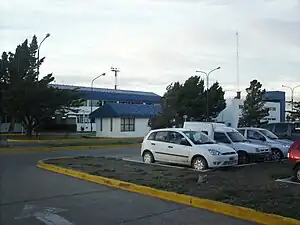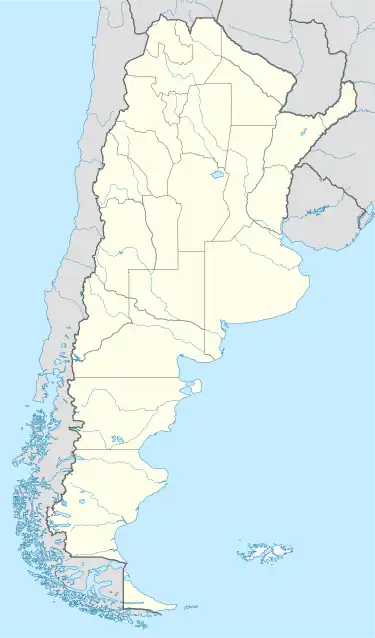General Enrique Mosconi International Airport Aeropuerto de Comodoro Rivadavia "Gral. Enrique Mosconi" | |||||||||||
|---|---|---|---|---|---|---|---|---|---|---|---|
 | |||||||||||
| Summary | |||||||||||
| Airport type | Public/Military | ||||||||||
| Operator | Aeropuertos Argentina 2000 | ||||||||||
| Serves | Comodoro Rivadavia, Argentina | ||||||||||
| Hub for | LADE | ||||||||||
| Elevation AMSL | 190 ft / 58 m | ||||||||||
| Coordinates | 45°47′07″S 67°27′56″W / 45.78528°S 67.46556°W | ||||||||||
| Website | www | ||||||||||
| Map | |||||||||||
 CRD Location of the airport in Argentina | |||||||||||
| Runways | |||||||||||
| |||||||||||
| Statistics (2016) | |||||||||||
| |||||||||||
General Enrique Mosconi International Airport (Spanish: Aeropuerto Internacional General Enrigue Mosconi) (IATA: CRD, ICAO: SAVC) is an international airport in the Chubut Province, Argentina serving Comodoro Rivadavia. The airfield is located 8 kilometres (5 mi) north of the city, covers an area of 810 hectares (2,000 acres; 3.1 sq mi), and has a 4,000 square metres (43,000 sq ft) terminal.[1]
The airport is the main hub of Líneas Aéreas del Estado (LADE).
History
It was built in 1929, and was officially inaugurated with an Aeroposta Argentina flight between Bahía Blanca and Comodoro Rivadavia vía San Antonio Oeste and Trelew on 1 November 1929. The new terminal was constructed in 1952. The airport was named after the Argentine military engineer Enrique Mosconi.
Aeropuertos Argentina 2000 has been operating the airport since the early 2000s.
On 22 November 2017, the longest non-stop flight ever made by the Royal Air Force (RAF) of the United Kingdom landed at the airport. The flight was part of the RAF's support in the search for the ARA San Juan (S-42) submarine which had disappeared days before. This flight also marked the first time an RAF airplane had landed at the airport since the Falklands War era.[4]
Airlines and destinations
Statistics
| Passengers | Change from previous year | Aircraft operations | Change from previous year | Cargo (metric tons) | Change from previous year | |
|---|---|---|---|---|---|---|
| 2005 | 271,777 | 8,331 | 1,128 | |||
| 2006 | 277,009 | 7,981 | 1,361 | |||
| 2007 | 289,750 | 8,621 | 1,080 | |||
| 2008 | 235,292 | 8,552 | 1,849 | |||
| 2009 | 338,473 | 9,704 | 868 | |||
| 2010 | 389,595 | 9,779 | 1,203 | |||
| Source: Airports Council International. World Airport Traffic Statistics (Years 2005-2010) | ||||||
Accidents and incidents
- 1956: An Argentine Army Douglas C-54A, tail number CTA-4, was damaged beyond economical repair at the airport, under unspecified circumstances. There were no reported fatalities.[5]
- 8 April 2004: An Argentine Air Force Twin Otter, registration T-84, force-landed 10 kilometres (6.2 mi) off the airport. Despite the aircraft sustaining substantial damage, there were no reported fatalities among the six occupants.[6]
See also
References
- 1 2 Movimiento operacional de los aeropuertos del Sistema Nacional - Año 2015- ORSNA Archived 23 January 2017 at the Wayback Machine
- ↑ "Airport information for SAVC". World Aero Data. Archived from the original on 5 March 2019.
{{cite web}}: CS1 maint: unfit URL (link) Data current as of October 2006. - ↑ Airport Council International 2010 World Airport Traffic Report
- ↑ "Llegó el vuelo directo más largo de la aviación militar británica para cooperar".
- ↑ Accident description for CTA-4 at the Aviation Safety Network. Retrieved on 8 March 2012.
- ↑ Accident description for T-84 at the Aviation Safety Network. Retrieved on 8 March 2012.